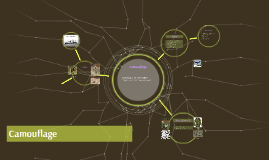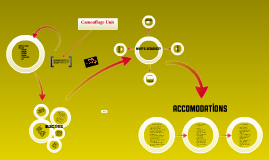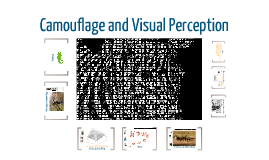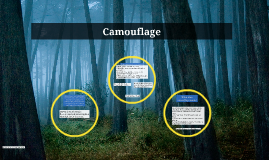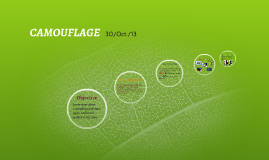CAMOUFLAGE
Transcript: invisibility cloak using optical camouflage by susumu tachi OP trees OBJECT MIMICRY uniform camouflage mimicry to help concealing industrial design form starfish city lászló moholy-nagy 1917 ship camouflage changes from grey to dazzle camouflage - more visible, but harder to target (break up form, confuse in course, speed) active camouflage technique using patterns, shadows, and moving parts PRACTICE II developed rapidly during the First World War counterillumination making animals or objects hard to sense trojan horse eric sloane - camouflage simplified (book 1942) not at home - private space knitted cocoon 1919 "dazzle ball" at the Chelsea Arts Club fusag - the ghost army IDEA POOL tobias rehberger strongly contrasting, non-repeating markings (spots or stripes) to break up the outlines decorating with pieces from the environment, to break up outlines, to conceal the features of bodies and to match the background Picasso claimed Cubists had invented dazzle camo cardboard box pattern disguising animals or object as something else which is of no special interest to the observer, imitation, masquerade changeable skin pattern / colour leibermuster / GER / 1945 ship camoufleur artists during WWI mainly marine animals that float near the surface with gelatinous bodies urban camouflage by aya tsukioka liu bolin fashion designers often use camouflage fabric for its striking designs, its "patterned disorder" and its symbolism AUDIO MULTICAM / US / 2002-2004, 2010- the ugly-green notebooks stand out by their colour, changing the cover to fit into the castle surroundings submerged hiding [our objects] camouflage against face-recognition algorithms just for fun erbsenmuster / GER / 1944-1945 study by How and Zanker in 2014 suggests that when moving, the stripes may confuse observers by two visual illusions: the wagon-wheel effect, where the perceived motion is inverted, and the barberpole illusion, where the perceived motion is in a wrong direction everyday camo patterns dazzle-pattern influenced fashion survaillance camera camouflage exploring graphic & textural qualities in camouflage bodies flattened, with the sides thinning to an edge, sides are fringed with white scales to hide and disrupt any remaining areas of shadow PRACTICE III URBAN CAMO cecilia paredes a vision for fashion that addresses the rise of surveillance, the power of those who surveil, and the growing need to exert control over what we are slowly losing, our privacy exploring new ways of cleaning urban camouflage (DE) marginalized urban groups (refugees, homeless, protesters) may need something against police repression based on cctv or other forms of digital surveillance. how to look something else? by clothing, shelter, vehicle DESIGN TASK present we & our work urme survaillance mask uses graded colour to counteract the effect of self-shadowing, creating an illusion of flatness can a painting or screenshot from a film act as a surrounding? what should be hidden and how in the chosen frame? hiding in a picture PRACTICE 1 reflection M90 / SWE / 1980's- ZSENNYE woodland / US / 1981-2006 patterns for everyday concealment concealing & emphasizing zsennye values countersurvaillance dress motion dazzle conceal shape TARGET GROUP faux facades • mesterséges intelligencia összezavarása / arcfelismerés átverése - privacy vagy pl google fotók megtévesztése • autók önjáró rendszereit összezavaró (sávtartó, követési távolság tartó, tábla felismerő rendszerek) metódusok • nem vizuális camo, hanem digitális, infravörös ourselves beginnings of military camouflage variety of camouflage schemes were used for aircraft and for ground vehicles in Second World War ghillie suits • bűvészet - egy nagy kamuflázs - álcázni azt, ahogy bemászik a dobozba • társadalmi különbség - egyenlősítés • optikai illúziók • robot mozgás ügyetlenségének másolása principles & techniques transparency edward wadsworth / norman wilkinson print all over me homeware disruptive break up the visual outline VIDEO MAPPING disguising something unwanted RANDOM IDEAS designs for people scared of crime DBDU / US / 1981-1995 aka. silvering a way to credibly threaten Pas-de-Calais dummies animals' colours and patterns resemble a particular natural background, their coloration matches the hues of its habitat home / moving rubber tanks, sound effects and carefully crafted illusions VR előadás • üres tér (papírtér) - VR egy változtatható layer rajta • szándékos megváltoztatás - félrevezetés olfatory auditory / sonar visual PRACTICE III misleading • eltűnés a városi tömegből - meditáció, privacy tereinek kialakítása • turista veszélyes környezetben - értékek elrejtése - ne legyen támadás áldozata • office camouflage Thayer's Law: "Animals are painted by Nature, darkest on those parts which tend to be most lighted by the sky's light, and vice versa" increasing range and accuracy of firearms in the 19th century / Napoleonic Wars personal concealment becomes essential camouflage as a defence against political






